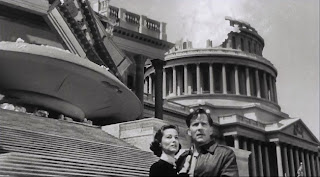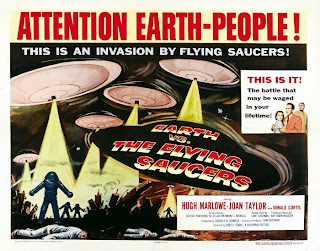___ ___ ___ ___ ___ ___ ___ ___ ___ ___ ___ ___ ___
What makes you think you can conquer us without a fight?!
___ ___ ___ ___ ___ ___ ___ ___ ___ ___ ___ ___ ___
After years of observation a race of belligerent aliens announce their hostile intentions of conquest with a show of power by obliterating the military base from which a series of orbiting satellite rockets were launched. (An opening salvo that eerily reflected Pearl Harbor in that an ultimatum was sent but went untranslated until after the attack itself.) Assuming the sturm and drang of their advanced brain-sucking technology and destructive weaponry will result in a quick capitulation, these invaders soon get a harsh lesson on the inherent folly of assumptions as the human race gives them the finger and then gears up for a counter-attack with the fate of the Earth in the balance.
On June 24, 1947, when aviator Kenneth Arnold spotted nine glowing disc-like craft streaking past Mt. Rainier at unheard of speeds, his report on these unidentified flying objects triggered a nationwide surge of similar "flying saucer" sightings and stoked the fires of speculation on their origin. One month later, in Roswell, New Mexico, initial reports of an actual crashed UFO stirred-up this growing controversy even more, though this "proof" was quickly refuted as a case of mistaken identity by the Powers that Be. Then, in January, 1948, things turned a little more sinister with a report that a UFO had shot down a pursuing P-51 Mustang near Ft. Knox, Kentucky. Now, whether the plane piloted by Captain Thomas Mantell was shot down or crashed after running out of fuel is still hotly contested to this day. What isn't is the overall keen of the public's reaction to these sightings after this particular incident. Once written off as fantastical tales of crackpots and publicity seekers, people demanded answers as to what these things were, where they came from, and, most importantly, what were their intentions? Were they Russian? Was this some kind of Nazi Doomsday weapon? Or something worse? And then, as the sightings and reports continued to pile up, the shit really hit the fan in 1952, when over the last week of July, several UFO's kept buzzing the nation's capitol and outrunning any and all pursuit planes, who, apparently, had Presidential authority to shoot them down if they refused to land as ordered.
Looking for answers, in the January, 1950, issue of True magazine, Donald Keyhoe, a retired Marine naval aviator and an ardent UFOlogist, wrote his treatise, Flying Saucers Are Real, where he postulated on the extra-terrestrial origin of these phenomenon and the government's ill-advised attempts to deny and cover this fact up. This article proved so popular the author expanded it into book which sold over a half-million copies. Keyhoe followed this up with another best-seller, Flying Saucers from Outer Space (1953), that detailed several of the encounters already mentioned and blew the lid off the alleged Roswell cover-up. And while Keyhoe felt these visitors intentions weren't hostile, just rubber-necking, basically, film producer Charles H. Schneer had other ideas and felt it was high time to cash in, cinematically speaking.
Teaming up with his new partner, Ray Harryhausen, it didn't take Schneer
long to convince Sam Katzman, his boss at Columbia, who easily remembered the profits the duo had made for him via It Came from Beneath the Sea a year prior, that the world needed another alien invasion flick. (George Pal's Tripod-turned-Flying Saucer War of the Worlds came out in 1953 and Winston Jones' docudrama, Unidentified Flying Objects: The True Story of Flying Saucers, beat Schneer's film into theaters by a couple of months back in 1956.) Securing the
rights to Keyhoe's book, Schneer and three other writers, including Curt
Siodmak (The Wolfman, The Magnetic Monster), George Worthing Yates (THEM!, The Amazing Colossal Man), and Bernard Gordon (Day of the Triffids), who, being
black-listed at the time, contributed under the pseudonym, Raymond Marcus, hammered
out a script based on Keyhoe's reports that would
ultimately climax with a rousing battle over Washington D.C., where his F/X team would leave no recognizable monument unmolested as, once more, good old American ingenuity overcomes any seemingly insurmountable obstacle. That's right, eat sonic-death, ya alien bastards!
Okay, now, even though former actor Fred Sears already had nearly two-dozen B-movies notched on his director's chair, most of them were westerns. Earth vs the Flying Saucers was his first F/X-driven picture and his unsure
hand shows badly in a couple of spots, especially in the all-too
noticeable rear-projection scenes -- and the clumsy editing on some of the
inserts and reaction shots during the final battle are even worse. However, these same folks also spliced in a lot of stock military and rocket footage with such great care and attention to detail that it makes those lazy second-unit inserts all the more frustrating. On the plus side, Hugh Marlowe is fine as the can-do square-jaw, ably supported by Joan Taylor, Morris Ankrum, Thomas Henry Browne, an over-modulated Paul Frees, and fast-shooting Donald Curtis. One cannot discount Mischa Bakaleinikoff's rousing score, either, that really sets the tone and hammers the action home. And, of course, being what brought us here in the first place, Harryhausen once more delivers the goods with a lot of wanton destruction and cosmic whiz-bangery.
Now, I think Jason and the Argonauts is Harryhausen's best film but The Valley of Gwangi is my favorite. And oddly enough, Earth vs the Flying
Saucers ranks third on both mental lists. But not Harryhausen's, who
ranks the film as his least favorite experience and end result. It's easy to see why at first glance,
what with the main attraction, those flying saucers, being fairly impersonal and sterile.
(And I'm sure fairly tedious and monotonous to animate.) But one wonders
if his attitude would be slightly different if he'd
been allowed to animate the aliens, too, as originally intended before budget
concerns nixed it. One of Harryhausen's greatest gifts has always been a knack for breathing life into his stop-motion creations -- and not only that, but bestowing a strong sense of personality in each and every one. Clay Campbell's armored alien suits are a little stiff, sure, but ultimately serviceable as a Plan B. And while
the saucers these arthritic-jointed pilots piloted could easily have been a series of simple models with sparklers shoved up their tailpipes or stagnant flying
hubcaps like the one in The Day the Earth Stood Still, one can and should appreciate the extra-effort in bringing the ones in Earth vs. the Flying Saucers to life. I love the
rotation, and the thought that went into the kinetics of it, with the sense that this is
how the machines generated there magnetic, gravity-defying fields. And the glorious, ear-splitting and spine-cracking whine
they make, pilfered from some ringing pipes buried deep in a waste-water treatment plant (-- which also served as mission control for Project Sky-Hook), tweaked and amplified
to such menacing proportions. I mean, damn. Wow. Don't tell me those things don't have any personality. In fact, aside from Medusa in Clash of the Titans and the Children of the Hydra in Jason and the Argonauts, I'm hard pressed to name a more menacing presence in Harryhausen's entire oeuvre.
Other Points of Interest:
Earth vs the Flying Saucers (1956) Clover Productions :: Columbia Pictures / EP: Sam Katzman / P: Charles H. Schneer / D: Fred F. Sears / W: Curt Siodmak, George Worthing Yates, Bernard Gordon, Donald E. Keyhoe (novel) / C: Fred Jackman Jr. / E: Danny B. Landres / M: Mischa Bakaleinikoff / S: Hugh Marlowe, Joan Taylor, Donald Curtis, Morris Ankrum, John Zaremba, Thomas Browne Henry

+1956.jpg)





















+1956.JPG)
+1956.jpg)

+1956.jpg)
No comments:
Post a Comment